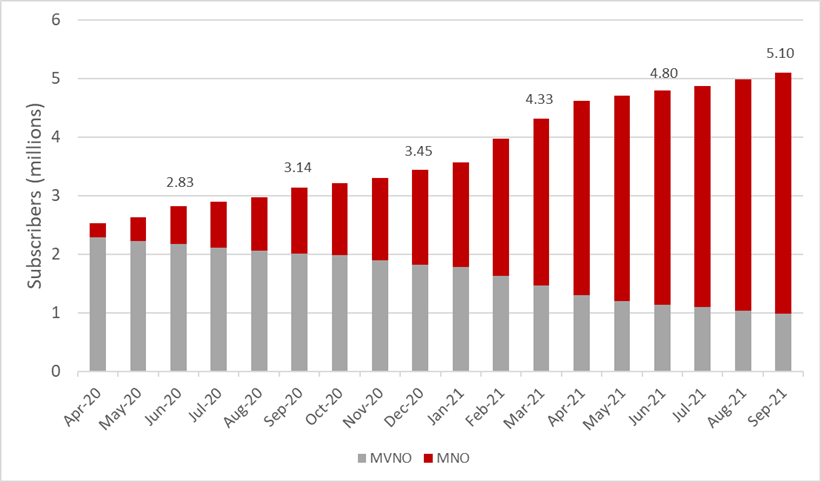Rakuten and Dish are pioneering the development of open, cloud-native 5G multi-vendor networks and operate in highly competitive and mature markets. Although with very different backgrounds, both are broadly similarly sized companies with established businesses. Both initially joined the mobile market as MVNOs and are at varying stages of deploying their own network infrastructure. However, there are also many important differences between the two companies, particularly with respect to their network architectures and vendor ecosystems.
Rakuten vs Dish
Rakuten has deployed a 4G network and ultimately intends to migrate all customers to a cloud-native 5G SA network. Dish will deploy a 5G SA core-based network from day 1. Rakuten has developed its own telco cloud with all network functions deployed at its own data centres located at various Rakuten premises. In contrast, Dish is adopting an “off-prem” model with the whole network running on AWS data centres, at least initially.
Rakuten relies mostly on single vendors with a heavy emphasis on its own in-house developed technologies and acquisitions. It also has ambitions to become a telco platform provider generating revenues from its software and technology expertise. Dish has generally adopted a dual-vendor strategy to avoid reliance on a single supplier. Although early days, Dish could conceivably follow Rakuten’s lead in time and similarly launch its own services platform.
Rakuten: Subscribers and Network Coverage
At the end of September, Rakuten Mobile had 5.1 million subscribers, having added just 2 million subscribers during the past 12 months, despite the recent expansion of its 4G network. In a country with a population of over 125 million, this is hardly a huge amount. In contrast, market leader NTT DoCoMo has more than 83 million subscribers.
Management still maintains – probably to alleviate investor concerns – that Rakuten will break even by 2023. It thus has a 12 to 18-month window to dramatically increase subscriber acquisitions. Offering much cheaper tariffs, the company is banking on consumers switching en-masse from bigger rivals, as well as finally being able to hit its 96% network coverage target in early 2022. However, in a largely cost insensitive market and with notoriously fickle consumers, will this be enough to attract sufficient new subscribers? Although the break-even target now apparently includes revenues from its telco software platform Symphony – perhaps a saving grace – management expects losses to be at their worst in the first quarter of 2022 but to improve from Q2 onwards.
In the likely event that Rakuten deviates from its planned 2023 break-even path, it is vital that the company can nevertheless show a substantial ramp up in subscriber acquisition over the next six months to demonstrate that its aggressive loss-leading pricing strategy can work in Japan. Otherwise, there is a danger that investors will start to lose confidence in the company, which may also extend to telco customers at its Symphony business.
 © Counterpoint Research, Data Source: Rakuten Group
© Counterpoint Research, Data Source: Rakuten Group
Exhibit 1: Rakuten Subscriber Growth
Dish: Network and Service Launch Plans
Against a backdrop of falling pay TV and MVNO subscribers, Dish faces challenges in both its established and new businesses. At its 3Q earnings call, the company reported 10,98 million pay TV subscribers, down 13,000 YoY and 8.77 million mobile subscribers, down 121,000 YoY. Up until now, Dish has been able to blunt the impact of its pay TV subscriber losses with higher prices. However, pricing power cannot last forever.
Dish claims that it will be able to build a fourth nationwide 5G network for $10 billion and plans to launch in its first market – Las Vegas – in early 2022. With regulatory deadlines to provide 70% population coverage by the end of 2023, it is now in a race against time to deploy its 5G network and make the business a success. As with Rakuten, network roll-out will be its biggest challenge initially. While using AWS for its core network may yield cost advantages, putting the entire 5G network in the public cloud is a risky bet, as the recent outages at AWS demonstrate.
Unlike Rakuten, Dish plans initially to target the wholesale and enterprise markets rather than focusing exclusively on the consumer market, where it lacks its rivals’ brand recognition. With its considerable spectrum assets, targeting the wholesale market looks like a no brainer. However, with limited network coverage initially, selling to enterprises will not be easy, plus Dish has no experience of working with enterprises. Despite its recent ties with AWS, it will be challenging to generate revenues from the enterprise market.
The Endgame – Big Tech Takeover?
Building a commercially successful network from scratch with new, innovative technologies that promise significant cost benefits is easier said than done. Rakuten’s progress to date has revealed a lot of issues and there are lessons here for other aspiring greenfield networks. While the contract award with 1&1 Drillisch demonstrates that there is demand for its technology, this is a business where scale and mindshare are required to be successful. With continued high cash burn and a high credit risk rating, any disappointment on the subscriber front over the next six months could hit investor sentiment as well as impact its ability to expand its Symphony business.
Like Rakuten in Japan, Dish is smaller than its main rivals and may also struggle financially, particularly as it will need to offer substantial discounts to attract customers. Counterpoint Research believes that an eventual takeover by a big tech company such as AWS, Google, Microsoft or even Apple looks the most likely outcome for Dish, while over in Japan, open RAN ambitions by domestic vendors, coupled with national pride, will probably ensure that Rakuten Mobile will survive in some form or other.
Related Reports
Rakuten’s Future – Operator, Vendor or Something Else?

 © Counterpoint Research, Data Source: Rakuten Group
© Counterpoint Research, Data Source: Rakuten Group